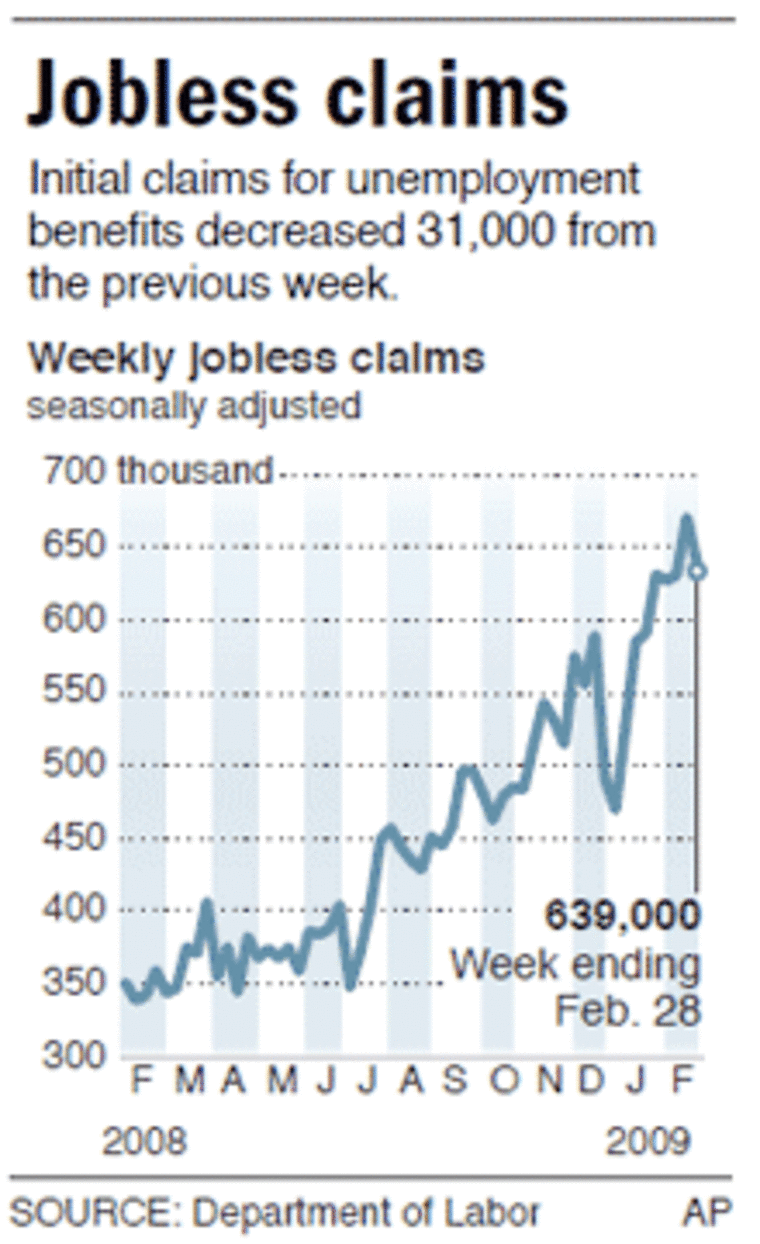The number of new jobless claims and the total number of people receiving unemployment benefits both dropped more than expected last week, though they remain at elevated levels and are unlikely to fall substantially in the coming months.
Few economists expect a turnaround in the battered labor market anytime soon with companies laying off thousands of workers weekly.
Still, the tally of initial requests for unemployment benefits fell to 639,000 from the previous week's figure of 670,000, the Labor Department said Thursday. Analysts expected a smaller drop to 650,000.
In separate reports, factory orders fell for a record sixth consecutive month in January, the Commerce Department said, as demand fell across a wide cross-section of industries. And worker productivity fell more steeply than previously estimated in the fourth quarter, the Labor Department said.
Retailers, meanwhile, said sales dropped in February but at a slower pace than the previous month.
The stock markets, already trading lower, extended their decline after the factory orders report. The Dow Jones industrial average dropped 132 points, or 1.9 percent, while broader indexes also fell.
The 670,000 new job claims total reported a week ago was a new high for the current recession and the most since October 1982, when the economy was emerging from a severe downturn, though the labor force has grown by half since then.
The number of people claiming benefits for more than a week fell slightly to 5.1 million in the latest report from 5.12 million, after rising to record-highs for five straight weeks. Analysts expected 5.15 million continuing claims.
But an additional 1.4 million people were receiving benefits under an extended unemployment compensation program approved by Congress last year. That tally was as of Feb. 14, the latest data available, and brings the total jobless benefit rolls to about 6.5 million.

That's up sharply from a year ago, when 2.8 million people were receiving benefits.
The four-week average of new claims, which smoothes out fluctuations, increased 2,000 to 641,750, the highest since October 1982.
More job losses were announced this week. General Dynamics Corp. said Thursday it will lay off 1,200 workers due partly to plummeting sales of business and personal jets that forced it to cut production and reduce its profit guidance for the year. Los Angeles-based aerospace company Northrop Grumman Corp. said Wednesday it will lay off 750 workers, mostly in southern California.
Elsewhere, Tyco Electronics Ltd., which makes electronic components, undersea telecommunications systems and wireless equipment, said it is laying off more employees, though it would not say how many.
London-based Diageo PLC, the world's largest producer of alcoholic drinks, said Wednesday it would eliminate 150 positions in North America next month. The company's brands include Ketel One vodka, Baileys and Captain Morgan. And Seagate Technology, meanwhile, said it is cutting 20 percent of its vice presidents and other top executives on top of previously announced layoffs.
"There can be no doubt that employers continue to shed labor at a frightening pace, with no end in sight," Ian Shepherdson, chief U.S. economist at High Frequency Economics, wrote in a client note Wednesday.
The nation's unemployment rate in January jumped to 7.6 percent, the highest in more than 16 years, while employers cut a net total of 598,000 jobs. The government will release February jobs data on Friday and many economists expect the unemployment rate rose to 7.9 percent while employers cut 648,000 jobs.
Among the states, Illinois reported the biggest increase in new jobless claims with a jump of 3,791 for the week ended Feb. 21, due mainly to layoffs in the construction, trade and manufacturing industries. The next largest increases were in Massachusetts, Missouri, Ohio and California.
Florida had the largest decrease, a drop of 3,586 claims, due to fewer layoffs in the construction, trade and service industries. The next largest drops were in Virginia, New York, Michigan and New Jersey.
In a separate report, the Labor Department said Thursday that worker productivity slid more than expected in the fourth quarter, while wage pressures shot up at the fastest clip in two years.
The department said productivity, the amount of output per hour of work, fell at an annual rate of 0.4 percent in the October-December period. At the same time, unit labor costs surged 5.7 percent.
While the combination of falling productivity and rising wage pressures would normally raise alarm bells about inflation, the threat of any resurgence of price pressures is seen as remote given the severity of the current recession.
The Commerce Department said demand for manufactured products dropped by 1.9 percent in January. That was smaller than the 3.5 percent drop that economists had been forecasting but it was still the sixth consecutive monthly fall, a record number of declines for a data series that goes back to 1992.
The weakness in January included a big plunge in orders for transportation equipment, reflecting the continued troubles facing automakers who are struggling with the weakest sales in decades.